Despite its incredible quality, the Eagle Buttress Traverse remains a little-known route… and there’s no record of it being completed in winter. So here we go, First Internet Winter Ascent (FIWA).
While Bennett, Ben, and I skied Deadwood Peak, Galina and Pat had attempted to make a winter ascent of the north ridge traverse on Eagle Buttress, one of the best easy alpine rock routes in the Tahoe area. Leaving the house at 7:30AM, by the time that Galina and Pat had gotten to the approach gulley the sun was soft and unsupportable, and after hours of wallowing in snowshoes they had only gained the ridgeline at 12:30, and pulled the plug.
All week, Galina and I had been talking about the buttress, strategizing what we’d do differently when she and Pat attempted it again- already scheduled for the following weekend. But when Thursday rolled around, Pat was debilitated by poison oak, my weekend plans had fallen through, and we ended up pulling together a new and different crew for the traverse.
So at 4:30 on Saturday February 27th, alarms went off and I, Galina, Bennett, and Becky emerged bleary-eyed for the first true alpine start we’d done in years. Coffee and packs came together, and at 5:37 we left the trailhead, walking in headlamps with stars still in the sky.
Forty minutes later we were at Eagle Lake, our boots crunching over firm snowfields on our way to the gully. Our goal was to get up the approach gully before the sun hit it, and we timed things perfectly- the snow was firm, the tracks from Galina and Pat’s previous attempt still gave good footing, and the shadow of Maggie’s Peak even gave us extra time to get out of the gully and onto the ridgeline. Cruising over snowbanks, we wrapped left around the buttress to find an easy 2nd-class approach to the notch, arriving around 8:30.

The summer route flows through a rock tunnel on the east side of the notch, but that was buried under deep snowbanks, forcing us to find an alternative. A gradual face above the notch beckoned with direct access to the ridge, and didn’t look too hard- probably only 5.6 or 5.7. Checking it out, I felt ecstatis- “We can probably solo this- should I head up?” I asked.
I’m glad Galina talked me out of it, because 5.6 in mountaineering boots feels like 5.10 in rock shoes. Leading the pitch, I found myself quickly out of my element: I scrabbled for purchase on the lichen-covered granite, unable to smear or to wedge my toes into the thin cracks. I was sweating and cursing as I fiddled in gear, trying to get solid gear before I pushed to get out of the corner and onto the next ledge. I took a break, I rested, I pushed, I fell, and then I finally got through, sweating and cursing and shaking on to the ledge. The next headwall, with little ledges for my feet and solid hand jams, was easier- and at this point, there was no turning back. A half-hour struggle up 50 vertical feet of terrain I thought I could solo, and I was on top- relieved, delighted, and elated to be on the ridgeline.
Once we all regrouped on the ride, we began the traverse proper, winding our way north through rock slabs and snow banks, feeling uncertain on our clunky boots as we smeared and climbed through the 4th-class ridge. The psychological crux of the route for me is a heady traverse along a sloping ledge, with an undercling for hands but a drop onto steep slabs 30 feet below. Bennett led that , and I’m glad I didn’t have to deal with it- smearing on sloping slabs in mountaineering boots will take some practice.
But after the two technical cruxes early in the route we hit our stride, working around obstacles as a team, with different people scouting ahead and always checking in to discuss options. The joy of 4th-class climbing is that you don’ t have to be a rope length away from your friends: instead, you can confer, brainstorm, and encourage each other upwards on each move. After flowing through much of the route on rock and mellow snowfields, we finally neared the prominent pinnacle that provides a landmark about 2/3 of the way along the route. Here, the route follows the east side of the ridge for a bit- just enough to provide a scary 60-degree snowfield hanging over a cliff. For the third and final time we roped up, protecting in rock across the sketchy traverse until we were back on sunny granite.
Nobody was excited to lead the pinnacle in mountaineering boots, and so we let our bodies recover in the sun while we took a leisurely lunch at 1PM, having been moving for over seven hours without break. The weather was turning, though- dark clouds were gathering to the west, and Freel looked fuzzy behind the beginning of a snowstorm. Packing up, the wind started whipping, and flurries and gropel were flying in our faces as we moved on, around another 60-degree snowfield and back onto rock. Our rhythm had been broken, and we were second-guessing our moves as we proceeded, our boots once again feeling uncertain and awkward.
The storm abated, and with it our mood lifted- sunshine spilling out across the ridge, giving light to the short section left before the ridge degraded into loose blocks instead of clean towers. Pushing right against our 3PM turnaround time, we scrambled through the last few notches and summits, before finally calling it quits at a convenient descent gulley. Like in the summer, we looped west back to the bast of the buttress, and caught our trail down and out.
Darkness caught us on the hike back to the car, and at the Eagle Falls bridge we finally took out headlamps for the awkward stairs lest we misstep. At 6:40PM we jubilantly loaded into the car- headed home for pizza, beer, and sleep after a long but rewarding 13-hour day.

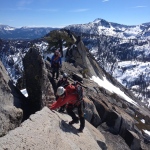

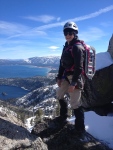
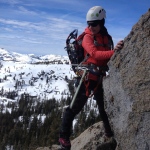
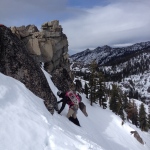
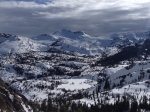


Trying this on Monday. Thanks for the only report out there 🙂 Did you guys need the snowshoes at all? I’m not too keen on “training”.
LikeLike
With an alpine start, we found that the snow was firm and didn’t need snowshoes (we hit the trailhead before 6AM). Try to get up and out of the gully before the sun warms it- fortunately as you’re going later in the season the snow should be more consolidated, but I’m sure it will get rotten if you’re in the gully at 9 or 10.
LikeLike
Thanks. We were on Tallac’s cross couloir on Wednesday, and snow was solid at 7000ft at 8:30 while we were there, I expect things to be similar. Didn’t need snowshoes that whole day, so trying to leave them behind.
LikeLike